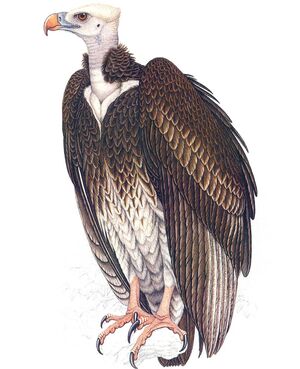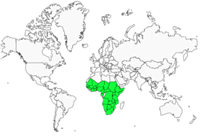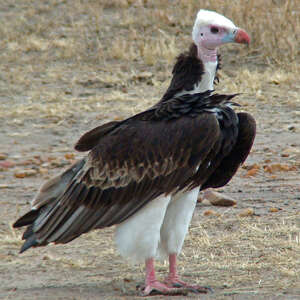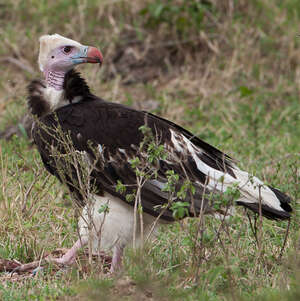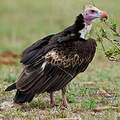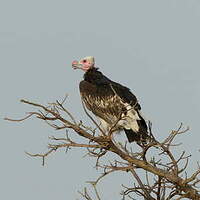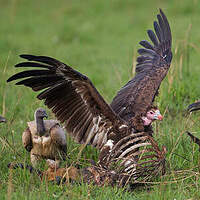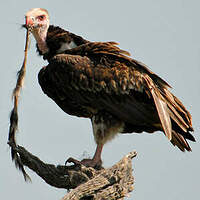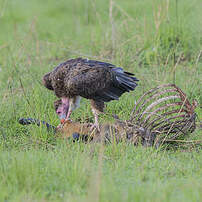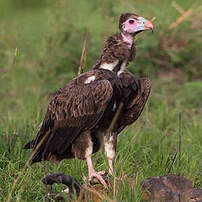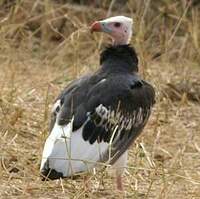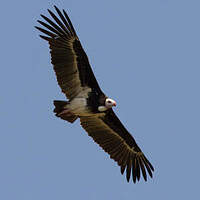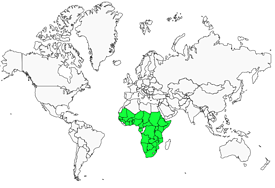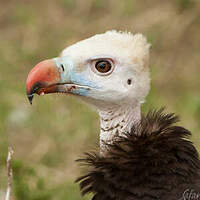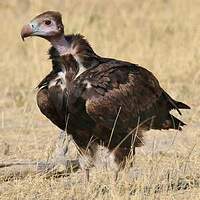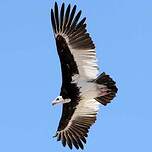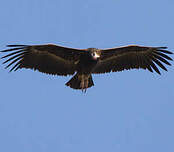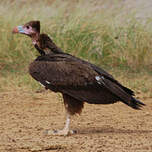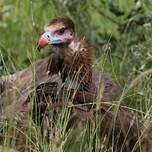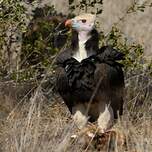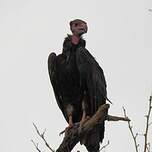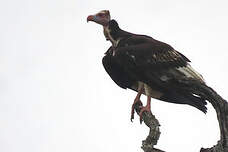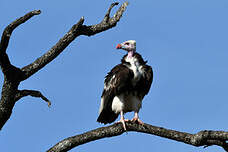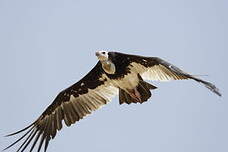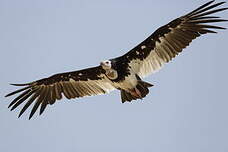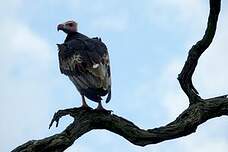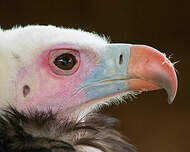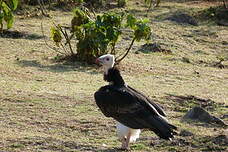White-headed Vulture
Trigonoceps occipitalis - Vautour à tête blanche
Identification
The White-headed Vulture is an average-sized vulture, intermediate between the scavenging vulture and the lammergeier with which it can be compared from a distance and from behind, but its white head is diagnostic.
The sexes are identical except for the inner secondaries and tertiaries, which are grayish brown in the male and white in the female, which can be clearly seen in flight. The female is 2% larger and 17% heavier than the male.
The head of the adult is remarkable. The crown and nape are covered with white down while the sides, as well as the top of the neck, are bare and flesh-colored. The back of the neck is adorned with a blackish ruff. The beak is red-orange with a blue base. The iris is yellow. The legs are pink.
The adults have dark brown upper parts. Their uniformity is simply broken by a lighter wing band on the medium coverts that are medium brown and edged with whitish beige. The secondaries are lighter black than black (except for the female who has white internals forming a clearly visible panel).
The bicolor pattern of the underside is typical. In both sexes, the blackish chest contrasts sharply with the white belly and legs. The female can easily be distinguished by the large white post zone formed by the inner secondaries and the belly. The white tip of the large underwing coverts and the white axillars form a white band in the middle of the wing, wide at the body level and narrowing to the wrist. The primaries are blackish with a white rachis.
The juvenile is entirely dark brown, above and below, including the top of the head, with vague fawn scales on the middle upper coverts and a narrow pale line under the wing, formed by the ends of the large coverts.The head and beak colors are slightly duller than those of their parents. The iris is brown. The juvenile may be confused from a distance with a Francolin vulture or a young Egyptian Vulture, both dark brown above, but the confusion is impossible from up close, in a group of vultures gathered around a carcass, which is frequent in Africa.
The young birds, whose plumage starts to change at one year of age, do not reach maturity, and hence do not acquire its perfect adult plumage, until 6 or 7 years old, after a succession of intermediate plumages.
Subspecific information monotypic species
Foreign names
- Vautour à tête blanche,
- Buitre cabeciblanco,
- abutre-de-cabeça-branca,
- Wollkopfgeier,
- gyapjasfejű keselyű,
- Witkopgier,
- Avvoltoio testabianca,
- vithuvad gam,
- Hvithodegribb,
- sup červenozobý,
- sup chocholatý,
- Hvidhovedet Grib,
- kirjokorppikotka,
- Witkopaasvoël,
- voltor de cap blanc,
- sęp białogłowy,
- Африканский белогорлый гриф,
- カオジロハゲワシ,
- 白头秃鹫,
- 白頭鷲,
Voice song and cries
Habitat
Behaviour character trait
The White-headed Vulture usually lives solo. It usually nests in isolated pairs. However, up to ten individuals may be found around a carcass.
An adult is sometimes accompanied by an immature. Both members of the pair perform high, circular flights above their territory. They sleep together near their nest long before the egg laying starts.The adult White-headed Vulture is mostly sedentary, unlike other common African vultures, which may occasionally make long journeys to find food. The immatures are more nomadic, being able to travel more than 100 kilometers during Africa's wet season in Western Africa.
Dietfeeding habits
White-headed Vultures mainly consume carrion, remains of large mammals, but more commonly the remains of smaller mammals and reptiles found close to roads after accidents, pieces of skin and other animal remains.
They also eat eggs, birds, insects and probably small mammals. They also consume flamingo eggs or larger insects they find on the ground, stranded fish or amphibians lying along the edges of dried-up ponds. They practice kleptoparasitism and steal their prey from other species such as marabou storks or even from other predators such as the Shikra. They have even been known to kill young flamingos. They are also known to attack living, modest-sized vertebrate prey such as mongoose, squirrels, monitors, etc.Immatures, and to a lesser extent adults, are almost always among the first scavengers to arrive in the vicinity of a carcass with young Savanna DJs. Unfortunately, they have to give up their place when the Long-billed Vultures or hordes of more common vultures arrive. They then find themselves on the periphery of the melee and have to wait to gather the small pieces that remain.
Reproduction nesting
The breeding season varies depending on the region: from October to November to May in West Africa, October to June in Ethiopia and Somalia, all months of the year in East Africa and from May to January in South Africa.
White-headed Vultures build a nest with branches of 80 to 170 centimeters in diameter and 20 to 60 centimeters in height. The interior is lined with straw and herbs. It is placed in plain view on the crown of a large, flat-topped tree, often an acacia or baobab tree, at a height of 5 to 20 meters. In Zimbabwe, Adansonia or Terminalia species are chosen first. The clutch usually contains only one egg which is incubated for 51 to 56 days. The young vulture takes flight after about 4 months (110 to 120 days). In the wild, Anthony was able to observe a strange phenomenon: a young White-headed Vulture being raised by a pair of Cape Vultures.Geographic range
These scavenging birds originate in the African continent south of the Sahara. Their distribution range is divided into five large entities: 1) Senegambia and Guinea-Bissau - 2) south of Mali, Burkina Faso, north of Cote d'Ivoire, Ghana, and Benin - 3) north-east of Nigeria, north of Cameroon, south of Chad - 4) south of Sudan, Ethiopia, Eritrea, Western Somalia in the direction of East Africa to Kenya, Uganda and north of Tanzania - 5) south of the DRC and Angola, Zimbabwe, Botswana, Zambia, western Mozambique and east coast of South Africa to Natal and Swaziland.
Threats - protection
IUCN conservation status
concern
in the Wild
threatened
evaluated
The population densities vary greatly, usually ranging from 0.25 to 1.2 pairs per 100 square kilometers. However, in Uganda and Cameroon, where this bird is relatively common, it can reach more than 9 pairs per the same area. In Southern Africa, from the Okavango to the Zambezi, there are about 500 pairs. Across the continent, populations estimated to be between 7,000 and 12,500 birds.
This raptor has a low productivity (only one egg hatched per nest, and a reproductive success of about 70%) and more than 60% of the birds do not nest every year, especially when there had been low rainfall. The species thus relies on its longevity, but this demographic strategy is unfavorable in an African context where human impact is growing stronger.
It is declining, particularly in South Africa, where poisoned baits and pesticide use are the main factors of mortality. The species is classified as vulnerable by Birdlife.
Sources of information
- IOC World Bird List (v14.1), Gill, F and D Donsker (Eds). 2024-04-18.
- Birds of Africa South of the Sahara, Ian Sinclair and Peter Ryan
- Birds of East Africa, C.A.W. Guggisberg
- Birds of Prey of Africa and its Islands, Alan and Meg Kemp
- Raptors of the World, a field guide, Ferguson-Lees James et Christie David
- Vol. 2 - Handbook of the Birds of the World, Josep del Hoyo-Andrew Elliot--Jordi Sargatal
- Avibase, Lepage Denis
- BirdLife International, BirdLife International
- Wikipédia, Wikipedia, The Free Encyclopedia
Other sources of interest
 Specification sheet created on
28/10/2023 by
Specification sheet created on
28/10/2023 by Translation by AI Oiseaux.net
published: 13-05-2011 - Updated: 22-05-2017
© 1996-2024 Oiseaux.net
- Accipitriformes
- Aegotheliformes
- Anseriformes
- Apodiformes
- Apterygiformes
- Bucerotiformes
- Caprimulgiformes
- Cariamiformes
- Casuariiformes
- Charadriiformes
- Ciconiiformes
- Coliiformes
- Columbiformes
- Coraciiformes
- Cuculiformes
- Eurypygiformes
- Falconiformes
- Galliformes
- Gaviiformes
- Gruiformes
- Leptosomiformes
- Mesitornithiformes
- Musophagiformes
- Nyctibiiformes
- Opisthocomiformes
- Otidiformes
- Passeriformes
- Pelecaniformes
- Phaethontiformes
- Phoenicopteriformes
- Piciformes
- Podargiformes
- Podicipediformes
- Procellariiformes
- Psittaciformes
- Pterocliformes
- Rheiformes
- Sphenisciformes
- Steatornithiformes
- Strigiformes
- Struthioniformes
- Suliformes
- Tinamiformes
- Trogoniformes

